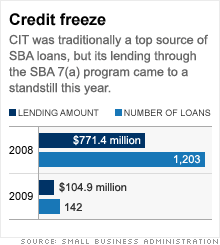CIT's long goodbye
CIT Group's collapse has been more than a year in the making -- and Main Street businesses began feeling the effects long ago.

 |
| Furniture supplier Ray Steele relies on CIT's factor financing services to keep his company running. |
NEW YORK (CNNMoney.com) -- When CIT Group filed for bankruptcy Sunday, it wasn't much of a surprise. The once-dominant small business lender has been largely sidelined for more than a year.
CIT Group was historically a major player in two key markets: lending to new and expanding businesses, especially franchises, and providing short-term financing for retail suppliers. On the retail side, CIT has stayed active, but its traditional lending has come to a near standstill.
Last year, CIT Group made more than 1,200 loans through the Small Business Administration's primary lending program, totaling $771 million. But in the 2009 fiscal year, which ended Sept. 30, its loan volume fell 88%. CIT Group made just 142 loans, totaling $105 million.
That sharp drop-off has left CIT's usual borrowers scrambling to find new financers.
"In the past, CIT has been an important lender to the franchise businesses," said Alisa Harrison, a spokeswoman for the International Franchise Association. "However, earlier this year they dramatically reduced their lending to the industry as a result of their financial problems, prompting franchise companies to seek alternative capital sources to replace CIT."
One popular franchise, Dunkin' Donuts, relied on CIT for years as one of its preferred lenders. But CIT's lending dried up as the economy deteriorated. "Lending volumes by CIT with our franchisees are certainly lower in 2009 than in previous years," said Andrew Mastrangelo, a Dunkin' Donuts spokesman.
Dunkin' Donuts insists that CIT's precarious financial state isn't hindering the company. "CIT's bankruptcy filing in no way affects our stores, their ability to grow or our ability to meet consumer demand," Mastrangelo said.
But others who track small business loans see ripple effects. Lending to small businesses has been cut in half this year, according to Bob Coleman, editor of the Coleman Report, a trade publication that monitors small business lending trends.
Outgoing CIT CEO Jeffrey Peek likes to call his company "the bridge between Wall Street and Main Street." Since last year, that bridge has been collapsing.
"This is why this is so terrible for Main Street," Coleman said. "If this were a GM plant, everyone would be screaming that we need to keep this GM plant there."
While CIT's traditional loan business dwindled, the company has stayed active in another field it dominates: factoring, a type of financing that lets companies borrow against their customer invoices.
Factor financing is popular in the retail field, where margins are paper-thin and manufacturers can't wait around for their customers to pay up. Selling accounts receivable to a factor, typically for 70 to 90 cents on the dollar, gives suppliers an immediate cash infusion and lets them pass on the administrative work of collecting payments from customers.
The National Retail Federation estimates that CIT providers factoring services to around 2,000 manufacturers, which in turn supply products to some 300,000 retail locations. For those suppliers, "there aren't a whole lot of other alternatives," said J. Craig Shearman, the NRF's vice president for government affairs. "There are a number of smaller firms that do factor financing, but not enough to pick up the slack if CIT were to drop out of factor financing all together."
CIT's factoring volume has dropped this year, largely in response to the weak retail market. In the first half of this year, it had a transaction volume of $16.5 billion, down 20% from the same period in 2008.
While CIT's holding company is in bankruptcy, none of its operating subsidiaries are affected by the filing. That means the company's factoring business is carrying on as usual.
Still, any trip through bankruptcy is going to leave a legacy, and those that rely on CIT are waiting to see how the situation will play out. One silver lining: CIT's bankruptcy happened late enough that it won't disrupt the critical holiday shopping season, when retailers typically rake in 25% to 50% of their entire year's revenue.
"We think we have dodged a bullet," Shearman said. "Most of the merchandise for the holidays is in the distribution centers, if not in the stores themselves."
Individual customers have so far stayed out of the fray. Ray Steele has been working with CIT since the day he and his wife opened their furniture supply company, Ultimate Accents in Kernersville, N.C. They are not planning on making any changes.
"We have been with CIT for 11 years and at this point have no reason to go elsewhere, unless something changes that we can't foresee right now," Steele said. "Since they continue to fund us uninterrupted, it is not a concern of ours right now. I mean, you fly on a plane of a company that is bankrupt, you buy a car from a company that is bankrupt."
CIT says its bankruptcy proceedings won't affect the company's day-to-day business. That's good news for Steele, because finding another factor financing company to work with wouldn't be easy. "It would be a big imposition on us, and it would affect our business -- as it would 99% of the other people that would be put in that position," Steele said.
CIT's bankruptcy followed months of negotiations with the government and with potential investors for a desperately needed capital infusion. The company's public struggles took a toll: The week of July 13, when CIT appeared poised to go bankrupt, customers drew down $700 million against CIT's financing lines, twice the normal transaction volume.
Also that week, Microsoft (MSFT, Fortune 500) and tool retailer franchise Snap-On gave CIT a no-confidence vote, cancelling financing programs they had in place with the company.
CIT said it has the capital it needs to continue its day-to-day operations. Through the bankruptcy reorganization, the company hopes to shed around $10 billion in debt and position itself for a return to profitability. A judge will hear its case on Dec. 8.
It's uncharted water. CIT's bankruptcy is the fifth largest in U.S. history, and among those companies, only General Motors has emerged with an intact operating business.
"It is not a slam dunk," said industry observer Bob Coleman. But "it is better than the alternative. Right now, you have a company that is dead in the water and can't do any lending."
Meanwhile, customers like Ray Steele are keeping their fingers crossed. "Everything so far seems to be fine," he said. "Hopefully it will continue to be that way." ![]()
-
The Cheesecake Factory created smaller portions to survive the downturn. Play
-
A breeder of award-winning marijuana seeds is following the money and heading to the U.S. More
-
Most small businesses die within five years, but Amish businesses have a survival rate north of 90%. More
-
The 10 most popular franchise brands over the past decade -- and their failure rates. More
-
These firms are the last left in America making iconic products now in their twilight. More










